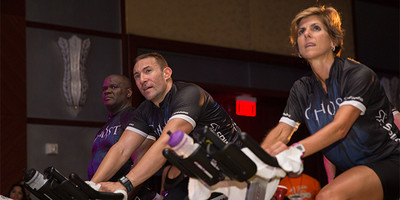
Combining Training and Trust in a Spinning® Program
Posted by Spinning® on Apr 18th 2018
By Dr. K.C. WilderPerformance in a Spinning® class is about combining training and trust to achieve your goals. Your riders should feel as challenged physically as they are engaged emotionally and mentally in the class experience. As a result, I have developed a unique way to teach a Spinning class called “Train-to-Trust.” I differentiate between a “training mindset” and a “trusting mindset” within the class, taking them through an imaginary criterium.An individual needs to develop the skill of a smooth, efficient pedal stroke before he or she can trust the stroke at a higher cadence and power-output. Simply put, a rider needs to be able to "train" in a movement to "trust" that movement. Developing the mental skill of transitioning from a training mindset to a trusting mindset enhances mental toughness. The controlled environment of a Spinning class provides an ideal setting to teach a rider how effective thinking and differentiating between a training and a trusting mindset positively affects performance in class.
What is mental toughness in the context of a Spinning class?
- Use a training mindset for practice and switch to a trusting mindset for consistent performance- Control what you can and let go of what you can't- Balance between a process goal and outcome goal perspective
- Use positive attributions to manage energy levels
- Remain free of fear or failure
How does Train-to-Trust help to instill confidence in your riders?
By preparing or training your riders progressively with the appropriate amount of challenge, you will increase their likelihood of perceived success. Increasing individual perceptions of success will gradually build intrinsic confidence and motivation. The greater one's intrinsic motivation is, the more that individual will push themselves slightly beyond their comfort zone both inside and outside of the class environment. The more often one tests the edge of their comfort zone and perceives success, the more often he/she can shift into a trusting mindset. Thus, the essence of the Train-to-Trust mental skill kicks into high gear.What type of goals do you present to your riders?
Present your riders with challenging yet attainable goals. Once a goal (such as setting a specific level of resistance and cadence) is met, you can incrementally increase resistance and cadence for the same Seated Climb in the next class. In contrast, if you begin at too high of a resistance or cadence level for a rider, you may be setting them up for failure. They can be intimidated by the expectation to reach an unrealistic goal or they may strive to reach the unattainable number on the Spinning Computer. They could fall short and lose motivation to dig deeper. In this scenario, they will stagnate and remain stuck in a training mindset.Here is a brief overview of the Train-to-Trust Spinning® class.
Be creative and use your imagination to teach a dynamic, engaging class that builds your riders psychological skills. At the beginning of class, define a training mindset as follows: A training mindset is left-brain oriented, highly analytical and is tapped into when concentrating on Spinning mechanics and technique. A training mindset is often the mindset used in warm-up, cool-down, recovery and technical skill drills.Next, define a trusting mindset: A trusting mindset is right-brain oriented and is focused in the present and with lots of confidence. A trusting mindset is when you are riding at a high-intensity, race-like effort. Sprints, hill climbs and high cadence flat roads are all done in a trusting mindset.The following cue words/phrases are suggested to use during class:Training Mindset:
- Practice good form
- Focus on form
- Pay attention to the skill
- Train the skill so that you trust it
- Stay in control
Trusting Mindset:
- Free-it-up, let it go
- Stay in the now
- You trained the skill, now trust it
- Let go of control
